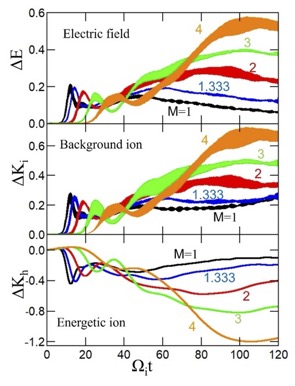Report
- Complex Global Simulation
- Report
Simulation study of energetic-ion mass dependence on nonlinear development of lower hybrid wave instabilities
In both space and fusion plasmas, energetic ions with a ring-like velocity distribution are present in various ion species with different masses. We study how the nonlinear development of lower hybrid wave (LHW) instabilities, driven by the ring-like energetic ions, depends on the mass of the energetic ions, by using the electromagnetic particle-in-cell simulation with a model where the energetic ions are continuously injected into a plasma. As expected from linear theory, the initial growth of the LHWs slows down as the energetic-ion mass (M) increases. However, long-time simulations have revealed that as M increases, the LHWs eventually grow to larger amplitudes. This is because the velocity distribution of the energetic ions, influenced by spreading due to wave development and reformation due to injection, can maintain a steep gradient when M is large. As a result, in a large M plasma, a greater part of the injected energy is converted to the energies of the electric field and background ions. In addition, it has been found that a larger value of M leads to an increase in the amplitudes of the second and third harmonics of the LHWs because of enhanced nonlinear wave-wave coupling.

The numerical simulations were performed on Plasma Simulator of NIFS.
【Publication】
DOI: 10.1063/5.0238485
